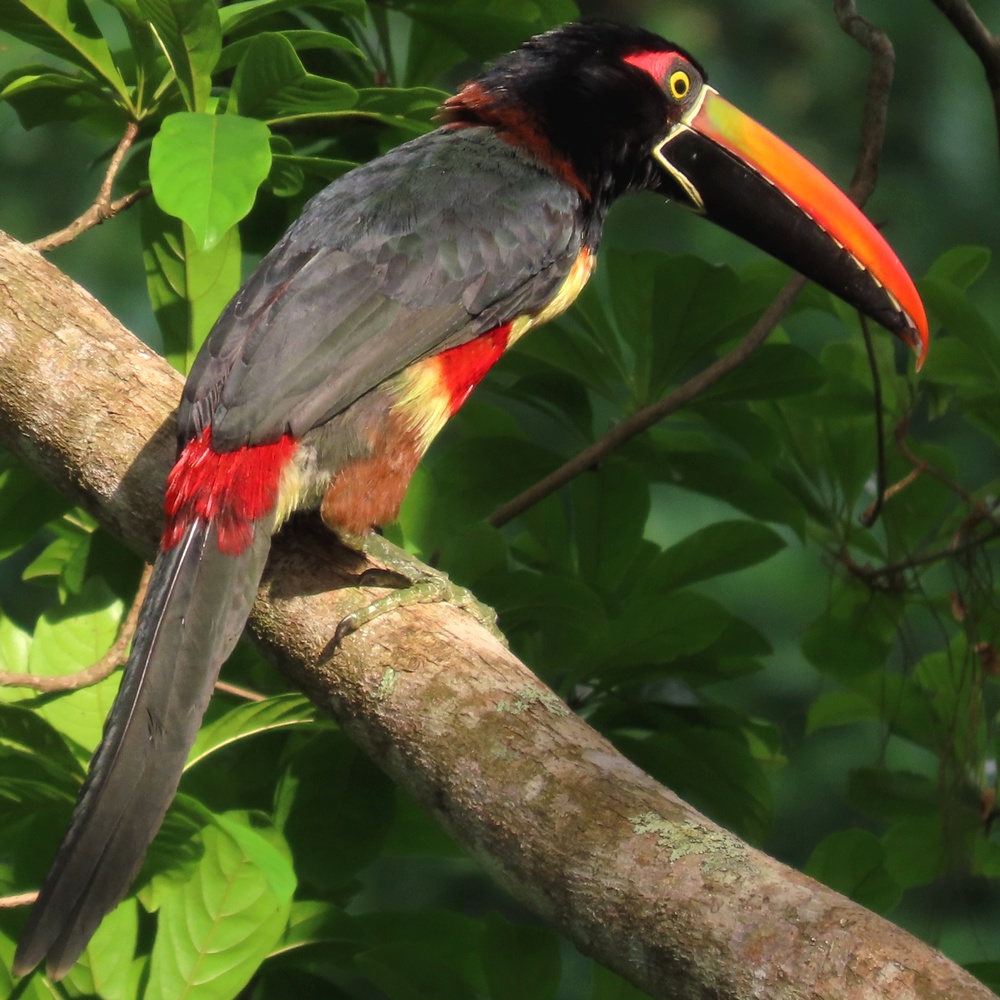Endemic species “Level 1*” (“classical”) – Page sponsored by Finca Amarillón
Family Ramphastidae (toucans) – Araçari de Frantzius en français
First publication: 17 July 2023 – Last update: 17 July 2023

This small toucan with a particularly colourful beak only exists on the Pacific slope of Panama and Costa Rica. It replaces the Collared Araçari which only occupies the Caribbean slope. Its range is therefore very limited and falls into the category “endemics of an EBA”, EBA being Endemic Bird Area (in this case, of the EBA of the Pacific slope of Central America). Its population is healthy and it can even be described as common in some places like Finca Amarillón.

Finca Amarillón is arguably the best place to photograph the endemic aracari
Although it is not a rare bird, this attractive species is restricted to Southern Costa Rica and Southwestern Panama. It needs lowland and mid-altitude forests that limit the number of sites where it can be found. We can therefore claim that few places in the world offer the chance to admire the Fiery-billed Aracari comfortably seated on a terrasse, drinking a good organic coffee or your delicious breakfast with fresh fruits.
Normally, expect to see at least one or two daily when you stay in Finca Amarillón; probably many more if you walk around the property and the neighbouring. It is a chance to get familiar with the calls, similar to those of the Collared Aracari, but distinguishable with experience. I strongly wish to be back there soon for many other species as well as for the aracari that I hope to show to my partner Marinella Mejia and to those of you that will join us. In this case, Marinella will be the one to cook the best meals for you there!
Valéry Schollaert

Its diet is usual for a toucan : fruits, insects and eggs. It is possible that he is particularly fond of eggs and species such as the Lineated Woodpecker need to protect his hole 24/24 when the aracari is present nearby. About woodpeckers, the aracari use their holes to breed, either old ones or news ones, then he then chases away. Little is known about the breeding. Chicks received mainly insects when very young then, later, receive more fruits. At least two eggs are layed. No detail about incubation and fledging is available.
Taxonomy
This is a monotypic species, related to the Collared Aracari. These two Pteroglossus are not, however, sisters. Genetic studies have shown a closer proximity to the Stripe-billed Aracari (Pteroglossus sanguineus) and the Pale-mandibled Aracari (Pteroglossus erythropygius).

Upper mandible, almost entirely orange, is unique among aracaris and even toucans in Central America. We can see numerous small “teeth”; it’s a difference with Collared Aracari that shows fewer teeth but much deeper.

We can clearly see the rufous-chestnut collar on the neck. It is large and of a relatively bright, so it is rather a male. The two sexes, however, are almost indistinguishable. The previous bird could be a female: what we see of the collar seems duller and the beak is a little shorter.

The shades of warm colours seem almost endless on this aracari. The beak is very orange, but its colour degrades towards green at the base via yellow; the red and yellow of the chest and belly, mixed in places, are again different. In addition, the spot behind the eye is more pinkish while the collar is more in chestnut tones.

In remote places such as the Osa Peninsula, it is more reckless and can stand in plain view on artificial infrastructure. This kind of observation is, however, uncommon.
Names suggested by Holistic Encyclopedia in six chosen languages.
- Spanish: Arasarí piquinaranja (*)
- Portuguese: Araçari-de-frantzius
- German: Feuerschnabelarassari
- Dutch: Vuursnavelarassari
- Italian: Aracari beccoflammeo
- Russian: Огненноклювый арасари
See names in dozens of other languages with Avibase
Listen to Fiery-billed Aracari voice in Xeno-Canto

[Species #0000 of the Holistic Encyclopedia of Birds project]

List of other species pages: taxonomical – day per day

All photos, tab and text are © Valéry Schollaert & Marinella Mejia 2023
